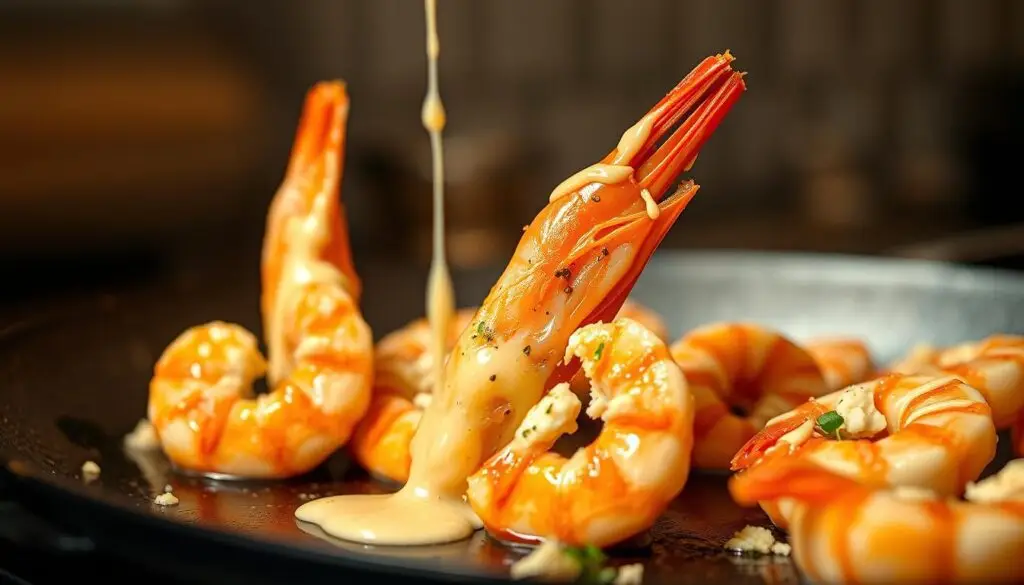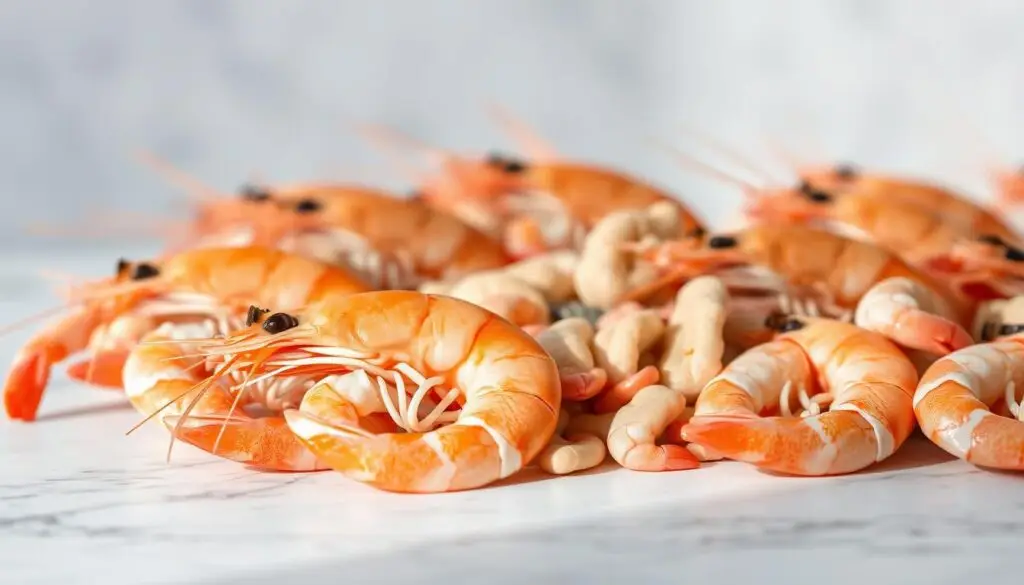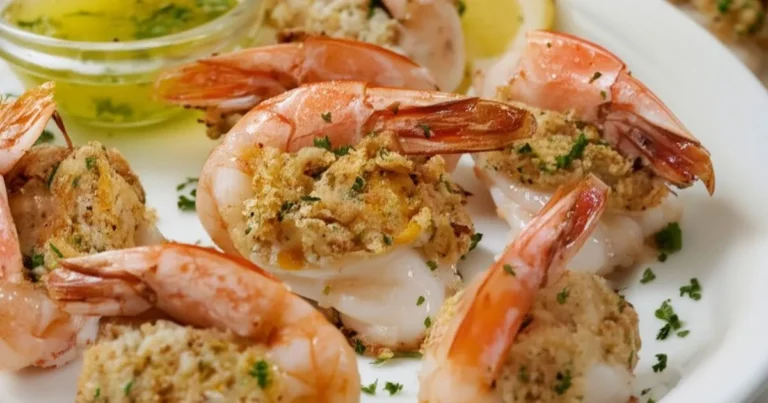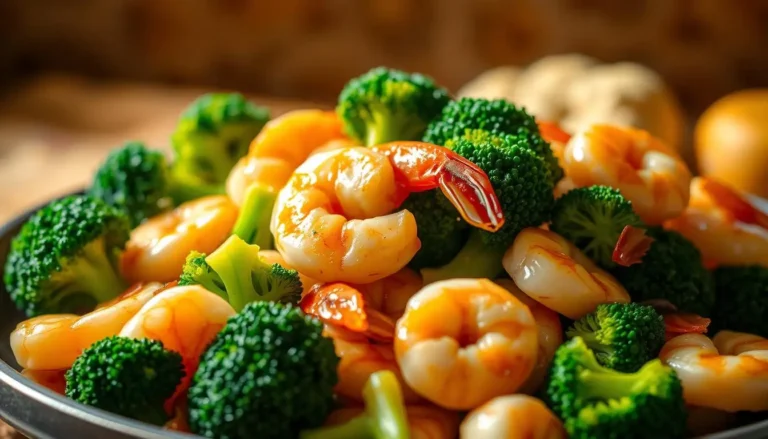best recipes for you
Explore our step-by-step guide on making stuffed shrimp from scratch.
Table of Contents

Making stuffed shrimp is like a work of art. It turns simple seafood into a fancy dish. Whether you love cooking at home or enjoy seafood, making crab stuffed shrimp is a great skill to learn. It’s easy to impress your guests with it.
This guide will show you how to make delicious stuffed shrimp. You’ll learn how to pick the best seafood and how to stuff it perfectly. You’ll get tips from pros that make your dishes taste like they’re from a restaurant.
Stuffed shrimp is a mix of soft shellfish and tasty filling. Our expert methods will help you make a meal that feels like a trip to the coast. You’ll see how simple ingredients can become a special dish.
Key Takeaways
- Learn professional techniques for preparing stuffed shrimp
- Understand ingredient selection and preparation methods
- Master the art of creating perfectly seasoned seafood dishes
- Discover insider tips for achieving restaurant-quality results
- Explore versatile stuffed shrimp recipes for various occasions
The Ultimate Guide to Selecting Perfect Shrimp for Stuffing
Choosing the right shrimp is key to making delicious stuffed shrimp with crabmeat stuffing. Start by learning how to pick the best seafood for your dish.

Understanding Shrimp Sizes and Grades
Shrimp sizes are measured by count per pound. For stuffed shrimp, go for larger sizes to fill them well:
- Jumbo (13-15 shrimp per pound)
- Extra Large (16-20 shrimp per pound)
- Colossal (U-10 or under 10 shrimp per pound)
Fresh vs. Frozen Shrimp Comparison
| Characteristic | Fresh Shrimp | Frozen Shrimp |
|---|---|---|
| Flavor Intensity | Peak freshness | Slightly reduced |
| Convenience | Limited storage time | Extended preservation |
| Price | Generally more expensive | More budget-friendly |
Signs of Quality Shrimp Selection
When picking shrimp for your stuffed shrimp, look for these signs:
- Bright, translucent appearance
- Firm texture without soft spots
- Clean, mild ocean smell
- No black spots or discoloration
Pro tip: Fresh shrimp should smell like the ocean, not fishy or ammonia-like.
Essential Ingredients for Classic Stuffed Shrimp

Starting with the right ingredients is key to making tasty shrimp and crab dishes. The quality of your stuffed shrimp depends on the ingredients you pick. Let’s look at the must-haves that will make your seafood dish stand out.
Primary Ingredients for Stuffed Shrimp
- Large shrimp (16-20 count per pound)
- Fresh lump crabmeat
- Breadcrumbs
- Butter
- Fresh herbs
Quality is crucial when making shrimp and crab dishes. Using fresh ingredients will make your dish unforgettable.
Key Ingredient Breakdown
| Ingredient | Purpose | Recommended Quantity |
|---|---|---|
| Large Shrimp | Protein base | 1 lb (16-20 count) |
| Lump Crabmeat | Stuffing texture | 1/2 lb |
| Panko Breadcrumbs | Binding agent | 1 cup |
| Unsalted Butter | Flavor enhancement | 1/4 cup |
Pro tip: Choose fresh ingredients when you can. Wild-caught shrimp and fresh crabmeat will make your stuffed shrimp recipe better.
Seasoning Essentials
- Kosher salt
- Black pepper
- Garlic powder
- Parsley
- Old Bay seasoning
Choosing the right ingredients is vital for your shrimp and crab dishes. Use high-quality, fresh ingredients for a dish that will wow your guests.
Kitchen Tools and Equipment You’ll Need
Preparing delicious stuffed shrimp needs the right tools and equipment. The right gear makes cooking smoother and more fun. Whether you’re new or experienced, the right tools make stuffed shrimp easy to prepare.
Before starting your stuffed shrimp recipe, get these essential tools. They ensure a great cooking experience.
Must-Have Preparation Tools
- Sharp chef’s knife for precise shrimp cleaning
- Cutting board dedicated to seafood preparation
- Large mixing bowl for combining stuffing ingredients
- Measuring cups and spoons for accurate ingredient proportions
- Kitchen shears for trimming shrimp
Recommended Baking Equipment
- Rimmed baking sheet for even cooking
- Ceramic or glass baking dish for presenting stuffed shrimp
- Parchment paper or silicone baking mat
- Meat thermometer to check internal temperature
Optional Specialty Items
These tools are not necessary but can improve your stuffed shrimp preparation:
- Piping bag for precise stuffing application
- Kitchen scale for precise ingredient measurements
- Seafood cracker for preparing fresh crab
- Decorative serving platter
Quality kitchen tools help you make restaurant-worthy stuffed shrimp at home. Your tools don’t have to be expensive. They just need to be functional and reliable.
Preparing Your Shrimp for Stuffing Techniques
To make crab stuffed shrimp, you need to prepare shrimp carefully. This ensures they taste great and are safe to eat. You’ll learn important skills for this.
Here are the main steps for preparing shrimp for stuffing:
- Thoroughly rinse fresh shrimp under cold water
- Remove shell while keeping tail intact
- Carefully devein using a sharp paring knife
- Create a butterfly cut for maximum stuffing potential
Deveining is key for clean, tasty crab stuffed shrimp. Start by making a shallow cut along the shrimp’s back. This exposes the dark digestive tract. Then, use a knife tip or a deveining tool to remove the dark vein.
The butterfly technique makes your shrimp perfect for stuffing. Cut along the shrimp’s inner curve but don’t split it all the way. This creates a pocket for your crab stuffing.
Pro tip: Always handle raw shrimp with clean hands and work on a sanitized surface to prevent cross-contamination.
By mastering these techniques, you can make crab stuffed shrimp that’s as good as what you find in restaurants. It will surely impress your family and friends.
Creating the Perfect Crabmeat Stuffing Mixture
Making a great stuffed shrimp with crabmeat stuffing is all about the right ingredients and how you prepare them. The perfect mix of flavors and textures turns simple shrimp into a fancy seafood dish that will wow your guests.
Selecting Quality Crabmeat
Your stuffing’s success begins with top-notch crabmeat. Here’s what to look for:
- Fresh lump or jumbo lump crabmeat
- Minimal shell fragments
- Bright white color
- Clean, sweet ocean smell
Seasoning Your Stuffing
Boost your stuffed shrimp with a mix of seasonings. Here are some great options:
| Ingredient | Flavor Profile | Quantity |
|---|---|---|
| Old Bay Seasoning | Zesty seafood blend | 1 tbsp |
| Fresh Parsley | Bright, herbal notes | 2 tbsp chopped |
| Dijon Mustard | Tangy undertone | 1 tsp |
Achieving the Right Texture
The stuffing’s texture is key. Too dry, and it’s dense; too wet, and it’s mushy. Mix gently to keep the crabmeat’s texture. Use breadcrumbs just enough to hold it together without overpowering the seafood taste.
Pro tip: Chill your stuffing for 30 minutes before stuffing. It helps it set and blend flavors better.
Step-by-Step Stuffed Shrimp Assembly Process
Making crab stuffed shrimp is all about precision and care. You want to mix delicate shrimp with rich crabmeat stuffing. It might seem hard, but with the right steps, you can make restaurant-quality stuffed shrimp at home.
Start by getting your workspace ready with all the ingredients. Clean and devein your shrimp well. This makes sure they’re ready for stuffing.
- Butterfly the shrimp by slicing along the back, leaving the tail intact
- Gently spread the shrimp open to create a natural pocket
- Pat the shrimp dry with paper towels to help stuffing adhere better
When filling your shrimp, use a small spoon to spread the crabmeat mixture evenly. Avoid overstuffing to prevent the filling from leaking. Press the stuffing gently to keep it in place.
For a professional look, follow these tips:
- Keep stuffing slightly mounded in the center
- Use toothpicks to secure the stuffing if needed
- Arrange shrimp with tails pointing upward on your baking sheet
Pro chefs say to chill your stuffed shrimp for 15-20 minutes before cooking. This helps the stuffing stay together and prevents it from separating during baking.
Mastering the Art of Seafood Seasoning Blends
Making delicious stuffed shrimp is more than just using good ingredients. It’s about finding the perfect mix of seasonings. The right flavors can turn your shrimp and crab meat recipes into something truly special.
Seasoning is an art that can make your stuffed shrimp stand out. Knowing how spices work with seafood can lead to dishes that are unforgettable. They will make your taste buds dance with joy.
Classic Seasoning Combinations
Professional chefs often use tried-and-true seasoning blends that pair well with seafood. For stuffed shrimp, here are some classic choices:
- Old Bay Seasoning: A traditional Maryland blend with celery salt, paprika, and red pepper
- Cajun spice mix with cayenne, garlic powder, and dried herbs
- Lemon-herb blend featuring dried parsley, thyme, and lemon zest
Regional Flavor Variations
Coastal regions have their own special ways of seasoning seafood. Your shrimp and crab meat recipes can explore unique flavors:
- New Orleans-style: Spicy Creole seasoning with a kick
- Mediterranean approach: Oregano, garlic, and olive oil blend
- Caribbean-inspired: Allspice, thyme, and scotch bonnet pepper
Trying out these seasoning blends can help you make stuffed shrimp that show off your cooking style. It also respects traditional flavors.
Baking Tips for Perfect Stuffed Shrimp Results
To get perfectly baked stuffed shrimp, you need to be precise and pay close attention. The right baking method can make your seafood dish truly special.
When you’re making stuffed shrimp with crabmeat stuffing, temperature and timing are key. First, preheat your oven to 375°F (190°C). This is the perfect temperature for cooking your seafood gently.
- Use a light-colored baking sheet to prevent burning
- Arrange stuffed shrimp in a single layer without overcrowding
- Cover with foil for the first half of cooking to retain moisture
Cooking times depend on the size of the shrimp:
| Shrimp Size | Baking Time | Internal Temperature |
|---|---|---|
| Large (16-20 count) | 10-12 minutes | 145°F |
| Jumbo (10-15 count) | 12-15 minutes | 145°F |
If you don’t have an oven, broiling is a great option. Place the stuffed shrimp 4-6 inches from the broiler. Watch them closely to avoid overcooking. You want them to be golden-brown on top and cooked just right.
Pro tip: Use a meat thermometer to check if they’re done. Shrimp are ready when they hit 145°F and look opaque with a firm texture.
Sauce Pairings and Garnishing Ideas
To make your stuffed shrimp truly special, think about the sauce and garnishes. The right sauce can highlight the flavors and add depth to your dish.
- Classic Lemon Butter Sauce
- Spicy Remoulade
- Garlic Aioli
- Creamy Herb Sauce
Crafting Complementary Sauce Recipes
A great sauce for shrimp and crab alfredo needs balance. Your sauce should bring out the seafood’s flavors without overpowering them. Aim for a light, creamy sauce with fresh herbs.
Elegant Presentation Techniques
How you present your dish is just as important as its taste. Top your stuffed shrimp with:
- Finely chopped fresh parsley
- Lemon wedges
- Microgreens
- Edible flower petals
For a fancy look, drizzle sauce in a pattern and arrange garnishes. Remember, we eat with our eyes first!
Common Mistakes to Avoid When Making Stuffed Shrimp
Making stuffed shrimp can be tricky for home cooks. Knowing the common mistakes helps you make dishes that taste like they’re from a restaurant. Let’s look at the mistakes that can mess up your stuffed shrimp.
- Selecting Low-Quality Shrimp: Always pick fresh, high-grade shrimp for your stuffed shrimp. Old or frozen shrimp can make the dish taste bad and feel wrong.
- Overcrowding the Baking Dish: Make sure each stuffed shrimp has enough room to cook right. If they’re too close, they won’t brown well and might get soggy.
- Incorrect Seasoning Techniques: It’s important to season stuffed shrimp just right. Too much or too little seasoning can mess up the taste of the seafood.
Getting the preparation right is key for perfect stuffed shrimp. Many home cooks forget to devein or clean their shrimp before stuffing. This can affect the taste and safety of the dish.
“The secret to amazing stuffed shrimp is in the details of preparation and cooking technique.” – Culinary Expert
Temperature control is also very important. Stuffed shrimp need to be cooked just right to stay moist and not get overcooked. You want them to be golden brown on the outside and soft on the inside.
| Common Mistake | Consequence | Solution |
|---|---|---|
| Overstuffing | Uneven cooking | Use moderate amount of stuffing |
| Wrong Cooking Temperature | Dry or rubbery texture | Bake at 375-400°F |
| Poor Ingredient Quality | Bland flavor | Use fresh, high-quality ingredients |
By avoiding these common mistakes, you can make your stuffed shrimp truly special. With practice and paying attention to the details, you’ll get better at making this tasty seafood dish.
Storage and Reheating Guidelines
Storing your crab stuffed shrimp right keeps the flavor and safety in check. Let the shrimp cool down at room temperature for 2 hours max. Then, put them in an airtight container to keep them fresh.
Keeping them in the fridge is crucial. Place them in the coldest spot, at 40°F or lower. They’ll stay good for 1-2 days. For longer, freeze them for up to a month. Wrap each shrimp in plastic wrap and put them in a freezer-safe container.
To reheat, the oven is best. It keeps the shrimp moist and tasty. Preheat to 275°F and cover with foil. Heat for 10-12 minutes. A squeeze of lemon or melted butter can bring back the flavors.
Make sure the shrimp is hot enough, at 145°F, before eating. If you’re in a rush, the microwave can help. But be careful not to overcook. Use a damp paper towel and heat in 30-second bursts, checking often.
FAQ
What type of crabmeat works best for stuffed shrimp?
Lump or jumbo lump crabmeat is perfect for stuffed shrimp. It offers great texture and flavor. These grades have large, tender chunks for a luxurious stuffing. Backfin crabmeat is also good if you’re watching your budget.
How do I prevent my stuffed shrimp from becoming too dry?
To keep stuffed shrimp moist, use a few tricks. Don’t overcook them. Add moisture-rich ingredients like mayonnaise or butter to the stuffing. A splash of white wine or lemon juice before baking helps too.
Covering the shrimp with foil during cooking also keeps them moist.
Can I prepare stuffed shrimp in advance?
Yes, you can prepare stuffed shrimp ahead of time. Assemble them and store them in the fridge for up to 24 hours. For the best results, add the stuffing just before baking.
What are some alternative seafood options for the stuffing?
You can try different seafood in the stuffing. Chopped lobster meat, scallops, or imitation crab are good options. Each adds a unique flavor. You can also mix different seafood for a more complex taste.
How do I know when the stuffed shrimp are fully cooked?
Stuffed shrimp are done when they turn opaque and pink. The internal temperature should be 145°F (63°C). The stuffing should be golden brown and hot.
They usually take 10-12 minutes in a 400°F (204°C) oven, depending on size.
Are there gluten-free options for stuffed shrimp?
Yes! Use gluten-free alternatives like almond flour or gluten-free breadcrumbs instead of regular breadcrumbs. Make sure all ingredients, including seasonings and sauces, are gluten-free. This makes the dish safe for those with gluten sensitivities.
Can I freeze stuffed shrimp?
You can freeze stuffed shrimp before cooking for up to 2 months. Wrap them in plastic wrap and then a freezer bag. Freeze them before adding wet ingredients to the stuffing.
Thaw them in the fridge overnight before baking. Add fresh herbs or breadcrumbs just before baking for the best texture.





